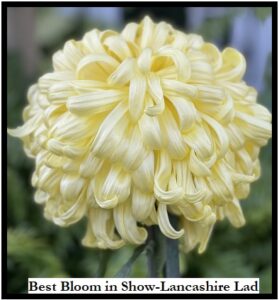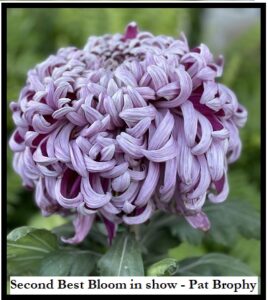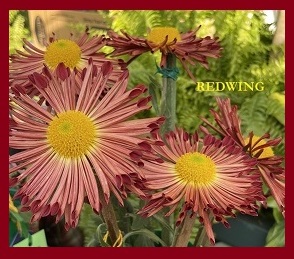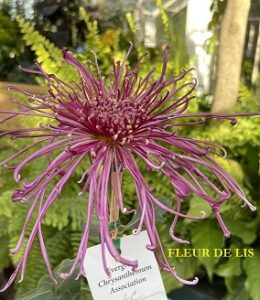EVERGREEN CHRYSANTHEMUM ASSOCIATION
Seattle, Washington
ecamumclub.org Nancy Halleen, Secretary
2012 GARDEN TOUR – The annual ECA garden tour and Picnic is scheduled for Sunday, August 12th. We will tour the Highline Botanical Gardens located in the Highline Community Center on 24th and 138th streets in Sea-Tac, meeting at 10 am to begin the tour. Our picnic will follow at the home of Ronnie and Sue Elliott.
Garden Location
The Highline SeaTac Botanical Garden is located just west of the intersection of S. 138th & 24th Ave. S. in SeaTac, WA, and just south of the North SeaTac Park Community Center. The community center’s street address is 13735 24th Ave S., SeaTac WA.
Driving Directions
From Interstate 5, travel west via SR-518 (SeaTac Airport/Burien freeway) about 3 miles to Des Moines Memorial Drive exit. At the stop sign, turn North onto Des Moines Mem. Dr. to S 136th. Right at S 136th, then right at 24th S, then right into Community Center complex at S 138th.
From Seattle travel south on Hwy 99 to SR-509. Take the S 128th St exit. Turn left onto S 128th, then right at 24th S, then right into Community Center complex at S 138th.
Garden located on south side of parking area.
This link has excellent directions.
Directions to Ronnie Elliott’s from this location are: Drive N on Des Moines way to 128th. West on 128th and get on 509 and stay on to the end heading south and then east under the airport and continue east on 188th going under I5 and following the road south (now Orillia Road) down into the Kent Valley which becomes 212th. Continue east on 212th up the hill to 104th/Benson highway and turn right and head south to 256th and turn heading east to 129th Ave. and turn right. Take the next left and go to the bottom of the hill on the right to Ronnie and Sue’s. Backstrom visited 7/23/12 and attests to the amazing collection of mums. “Easy to see why he (Ronnie) was CHIEF MANY POINT”.
Members are bringing salads, desserts, snacks, chips, hors d’oeuvres etc. If you have not yet responded to Ronnie Elliott for a picnic count, contact him by phone or email. We’re counting on YOU, come and have a great time.
LOOKING FORWARD TO SEEING EVERYONE AT THE PICNIC
PLANT CULTURE and SUPPLIES: – Place orders for specific items with Don Stark. Cultural recommendations are attached for August and September. It is time to consider your sheltering options for September as we move to the latter part of the growing season.
See Don Starks Revised Feeding Schedule for Bloom Cycle in Notes below
Other EVENTS:
Puyallup Fair: At this time, chrysanthemums will be shown in three cut flower shows. They may be entered in the Perennials Division on September 7, 14th, and 21st. This is a change from previous years as the Floral building is no longer available. Floral exhibits will be housed in the Americraft ShowPlex, sharing space with the Ag-Hort Department.
You will need to pre-register online at the Puyallup Fair website www.thefair.com . Go to entries and then floral. An entry schedule may be printed from there if you have computer access.
If there are changes to these entry divisions, Mark Ross and Nancy Halleen will do their best to keep everyone posted.
As a reminder, please send any email address or postal address changes to Nancy Halleen. To receive future monthly notices by email only rather than US mail, please send Nancy an email.
EVERGREEN MUM CLUB Rev Aug 3, 2010 drs
Revised feeding Program for Bloom Cycle
By mid August, after the buds are taken, it’s time to revise our feeding program. We will be switching to new formulation that is much higher potash content and reducing the amount of feed through the bloom cycle. Here’s the plan:
1. As soon as the bud has been taken, reduce your feeding level to ½ what you have been using. If you have been feeding really heavily, you might have to reduce further. A good position at this time is ½ tsp per gal of water once a week.
2. Starting mid Aug. we do two things. First feed each pot ½ tsp granular potash and 2 weeks later repeat with 1/4 tsp potash.
-When the buds break in late Aug or Sept, it’s time to change to a new fertilizer formulation with higher potash concentration. This will harden off the plants and promote better bloom development. We have been unable to find the old standby’s 15-10-45 or 20-5-30 so here’s the new recommendations for late feeding.
Liquid feeding formulation
– 1/2 tsp of the standard 20-9-20 plus ¼ tsp Sulfate of potash fertilizer per gallon of water.
Note:, the sulfate of potash doesn’t dissolve readily, so you might try mixing it with a small amount of hot water and letting it set overnight.
-Watering: The plants wont require as much water during this cycle, so you should apply only a pint of water per pot. Likewise, only a pint of your liquid fertilizer mix at a time
– after the bloom petals have emerged and dropped 1 ½ to 2 inches you may want to increase the feed by feeding more often than once a week., but use caution because you can blow the blooms with too much fertilizer
AUGUST TO DO LIST – Revised July 2005 by Don Stark and Bob Walker
Use B-Nine to retard neck stretching. According to the B-Nine directions: To reduce neck stretching just below the flower on potted and cut Chrysanthemums, spray the top 1/3 part of the foliage to run off with 0.25% (2500 ppm) B-Nine two days after disbudding. -0.25 % translates into 2 level table spoons per gal. –
– Gigantics and possibly Seychelles immediately come to mind as likely candidates for this use. Maybe some of you will want to give it a try. ( Don Stark, 7/25/2012)
August is a major growing month. Continue with the watering, feeding, and pest control programs noted in the July newsletter. l The appearance of bud color, especially for the early cultivars, signals a shift to the late season feeding program. Flush the pots at least once during the month to reduce the accumulation of fertilizer salts in the pot. Disbudding is the primary cultural activity for the first half of August. Stake and reduce the number of laterals as the buds appear and are secured. Experience suggests there is no way to get too much support for laterals and blooms. Top-dress the plants with fresh potting mix to assure maximum plant growth now and new shoots for next season.
1. Staking and Lateral Control
• Surplus laterals are removed as the buds are firmly established for all varieties with the exception of incurves (classes 3, 13, and 23) and some intermediate types (classes 5, 15, and 25), which are culled in early September. With 2 ½ months until the ECA show, it may be conservative to wait a few more weeks for the final reduction in the event of bug damage, wind, or accidents.
• Reduce the number of laterals to the final count as listed below. For early varieties follow last number, ex. #14 and #24 use #4.
• For #1 and #2 cultivars, carry 1 or 2 laterals.
• For #3 cultivars, carry up to 5 laterals, cull to 3 in Sept.
• For #4 cultivars, carry 2 or 3 laterals.
• For #5 cultivars, carry 2 to 5 laterals.
• All laterals should be individually staked Fasten the laterals with “twist’ems”. If the laterals are not staked or otherwise supported, they break off with rain or breeze and also grow crooked, making the resulting bloom difficult or impossible to enter in shows.
2. Blooms and Bloom Support
• Watch for buds and secure them as they appear. Most buds appear by August 15. Look for “rabbit-ear” leaves below the bud and laterals forming at leaf axils. As the bud reaches about ¼ inch, or the size of a small pea, it should be secured by removing the ring of side buds and the other side shoots that may appear in the leaf axils below. Keep those new laterals removed. This grooming of the selected laterals will require regular and sometimes daily attention.
• Prepare strips of wood 16-18 inches long and 3/8” wide made from shingles, shakes, or ¼” plywood. Stain them green preferably. These are used to support each bloom and are secured with two “twist’ems”. Place them on the bud/lateral as the bud over-grows the stakes to protect the lateral and bud, to keep the lateral growing straight, to support the bloom, and keep the bud horizontal. A “cocked” bloom will never win a blue ribbon.
3. Feeding & Top-Dressing
• Top-dress the pots in early August and again when the buds show color, about September 1-15. Put about 1 handful of compost or Soil less mix on the surface of the pot and level it each time you top-dress.
• Water thoroughly when you water and then almost dry out the plant before watering again. If plants are yellow, first try drying them out. If drying out fails, feed ½ teaspoon Epsom salts per plant or carefully use of one of the liquid iron solutions.
• Continue fertilizing until buds appear with the mid season fertilizer program as described in the July to-do list.
• Flush the pots once per month to prevent fertilizer salts build-up.
• The appearance of the bud especially for the early cultivars, also signals a shift to the late season feeding program. When the buds appear, stop or reduce feeding ½ strength for 1-2 weeks and water the plants more sparingly. At this stage it’s time to change the feeding program to a late season fertilizer. Either switch to a high potash fertilizer (15-11-29) or continue with the 20-10-20/20-9-20+ fertilizer and add approximately15 % by volume of Murate of Potash. In either case continue to fertilize at ½ to 2/3tsp per gal of water.
4. Pest Management and Housing
• Review your pest management program every two weeks and correct as necessary. Have your plants free of aphids and fungus before the blooms are set to open. Aphids in blooms are cause for disqualification at shows.
• Spray every two weeks with a fungicide or an insecticide/fungicide if not using Marathon as an insecticide.
• Watch for and destroy earwigs. They wreck blooms when they get inside.
• Finally, anticipate your housing needs and start preparations to get your show flowers under cover by the first or second week of September.
Don Stark, 4 July 2005
SEPTEMBER TO DO LIST – (adapted from Don Stark 9/98 notes)
Once the buds have broken the membrane and some petal tips are showing, it is time to get the pots into or under some kind of shelter. The basic idea is to protect the blooms from rain and dew. If rain or dew is present when the sun strikes, you will almost certainly burn the florets. Shelters come in a variety of sizes, names, and shapes including porches, large overhanging eaves, garages, greenhouses, and temporary wood and plastic structures.
Sheltering Plants During the Bloom Cycle Starting September 1
• Shelter requirements are daytime light (though it can be shady), ventilation, and temperature control.
• Maximum temperature should be kept below 80 degrees F if possible. Above that temperature the probability of bloom damage due to petal rot is high. If the shelter is exposed to too much sun in the early Sept days, the temperature within the shelter can skyrocket.
• Big fans keep the air moving and the temperature down. Fans also hopefully can bring air from a shady side of the shelter to cool the overall area as well.
• Lining the inside of the shelter with old sheets or muslin will also reduce the heat and filter the sunlight.
Bring Pots Into Cover
• Wash the pots to get rid of the crud and residue from the growing area.
• Pick off old dead and damaged leaves (mostly at the bottom of the plant) that harbor pests and fungus.
• Spray the plant with a fungicide and insecticide before taking to the shelter.
• Watch for and destroy earwigs. They wreck blooms when they get inside.
• Top-dress the pots again. Put about ½ to ¾” of the 9-Inch mix or Soilless mix on the surface of the pot and level it. Top-dressing the plants helps finish plant growth now and also promotes shoots on the plant stools for our next growing season.
• Optionally, add ¼ teaspoon FeSo4 to enhance color. Do not add to plants with white or yellow blooms.
• Add ¼ teaspoon of Potash to help harden off the plant and keep the blooms from being too soft.
Plant Clean Up and Cut Back to Final Lateral Count
• As the plant goes to shelter, if not already done, cut back to the final lateral count selecting the best overall laterals. For #1’s keep 1 or 2 blooms per plant, #2’s keep 2 blooms per plant, #3’s and others excluding specimen plants keep 2 to 5 blooms per plant.
• Stake and tie up the selected laterals and add support shingles for the blooms as you house the plant.
• Remove or pick off the side laterals on the selected stems.
Fertilizing & Watering
• For late season fertilizing, reduce fertilizer to ½ strength for 2-3 weeks. After the petals start to fall, gradually increase feed. Switch to a higher potash fertilizer along the lines of a 15-10-30 or other bloom feeder fertilizer and go lightly.
• Watering is different at this stage as the plants are kept a little dryer at this stage. Water plants more sparingly, using about 1 pint per watering. Do not water when the temperature exceeds 75F.
• There are two schools of thought as to the best time of day to water. Previous year cultural notes recommend to water in the evening as the day is cooling down to help avoid sending the plant sap to the blooms in heat of day and blowing out or cracking the bloom neck. Bob Walker recommends watering in the early part of the day.
• Water/fertilize from a bucket using a 1-pint jar or similar small container. Do not use the hose and spread water everywhere on the shelter floor. Keep the finishing area dry and clean.




